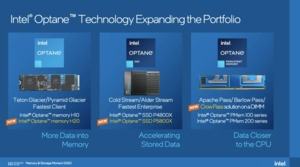Intel introduces new Optane, TLC and QLC SSDs
Source: Hardware Luxx added 16th Dec 2020At the Memory and Storage Day Intel has some news from the area of NAND and Optane memory presented. Two points played an important role in the course of the event. On the one hand, Intel once again announced the sale of the NAND flash division to SK Hynix. This should be completed by 2025. Secondly, Intel wants to focus more on its own Optane memory.
One of the innovations is the Optane SSD P 5800 X with the second generation of Optane memory, which is implemented here in the form of a PCI Express 4.0 SSD. The Optane SSD P 5800 X is said to be three times faster than its predecessor, the Optane SSD P 4800 X . The improved Optane memory is one of the things that contributes to the higher performance. Another is the fact that the Optane SSD P 5800 X is connected via PCIe 4.0 with four lanes and thus has the prerequisites for high data throughput. Intel speaks of 7.2 and 6.2 GB / s for reading and writing data. For 4K data, the IOPS is 1.5 million. For 512 byte accesses there are even 4.6 million IOPS.
A The factor that plays a special role with the Optane SSDs is the fact that they still have low latencies in the range of 10 to 100 ns. While the latencies with classic SSDs of 84 ns keep increasing with increasing bandwidth, they remain with the Optane SSD P 5800 X still in the low range even at 8 GB / s.
The DWPD (Drive Writes Per Day) gives Intel with 100 at. Depending on the model, the capacity of the SSD is 400 GB, 800 GB, 1.6 TB or 3.2 TB.
As the successor to the Optane Memory H 10 Intel presents the Optane Memory H 20. The new generation of Optane memory is also used here, which is still combined with QLC-3D-NAND at this point. The Optane memory is always 32 GB, the additional NAND 512 GB or 1 TB. The connection of the SSD remains with PCIe 3.0 x4. From the second quarter 2020 the H 20 will be available, or will be installed by system providers from then on.
Pure NAND SSDs are also available
But not only the Optane memory or its combination with classic NAND were in focus at the Memory and Storage Day – “classic” SSDs are also presented. This includes the Intel 3D NAND SSD 670 p, which comes with the new 144 – Layer QLC-NAND is equipped and is intended for the entry-level area of SSDs.
The Intel SSD D7-P 5510 is the first 144 – Layer TLC-NAND SSD, which is still in should be available this quarter. The U.2 SSD will have a storage capacity of 3, 84, or 7, 68 TB.
The Intel SSD D5 uses the same memory -P 5316. It will be available in the first half of the year 2021 and come on the market in U.2 and E1.L format. The capacities are 20, 36 and 30, 72 TB.
